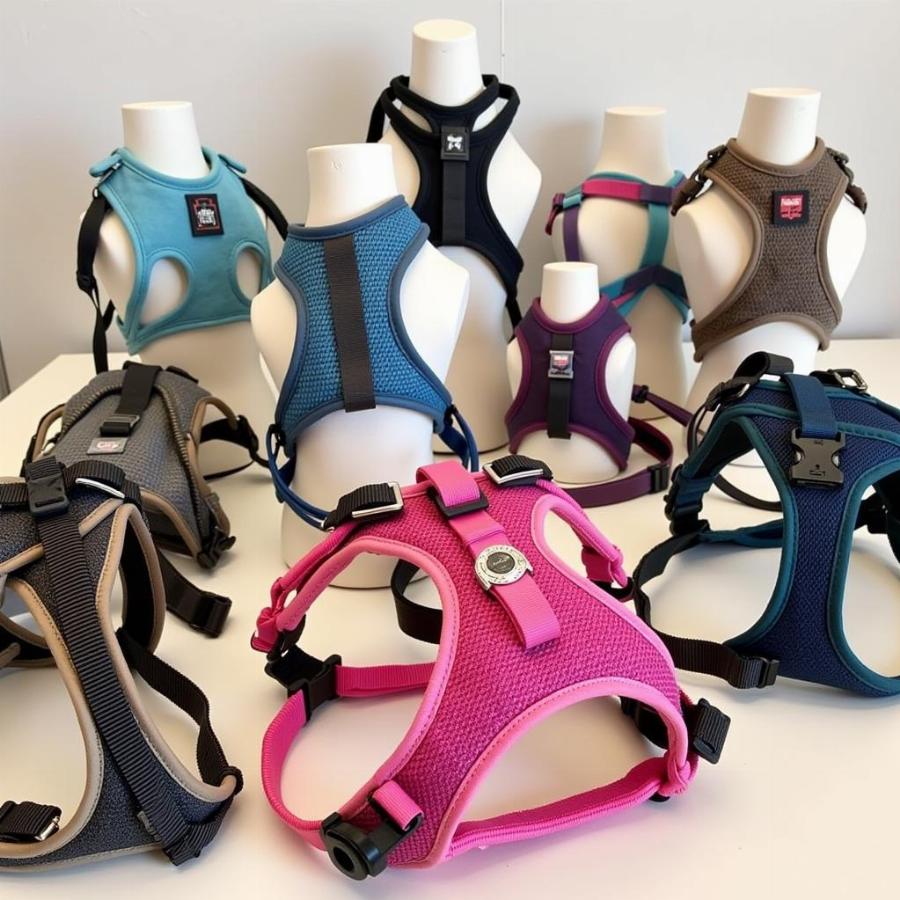A female dog harness is more than just a stylish accessory; it’s a crucial piece of equipment that ensures your furry friend’s safety and comfort during walks and other activities. Finding the right female dog harness can be a daunting task, with a plethora of styles, sizes, and materials available. This comprehensive guide will delve into the world of female dog harnesses, helping you choose the perfect one for your beloved companion.
 Choosing the right harness for a female dog
Choosing the right harness for a female dog
Understanding the Importance of a Female Dog Harness
Why choose a harness over a traditional collar? For female dogs, harnesses offer several key advantages. They distribute pressure evenly across the chest and back, reducing strain on the delicate neck area, which is particularly important for smaller breeds or dogs prone to tracheal collapse. Harnesses can also provide better control, especially for energetic pups who tend to pull on the leash. Additionally, certain harness designs can be helpful for dogs with specific needs, such as those recovering from surgery or those with mobility issues.
Types of Female Dog Harnesses: Finding the Right Fit
There are numerous types of harnesses designed for female dogs, each catering to different needs and preferences. Here’s a breakdown of the most common types:
- Step-in Harnesses: Easy to put on, simply have your dog step into the leg holes and fasten the buckles. Ideal for smaller breeds or dogs who don’t like having things pulled over their heads.
- Over-the-Head Harnesses: These slip over the dog’s head and fasten around the chest and back. Often preferred for their secure fit and ease of adjustment.
- Front-Clip Harnesses: The leash attaches to a D-ring on the chest, which can help discourage pulling by gently redirecting the dog’s attention.
- Back-Clip Harnesses: Suitable for dogs who don’t pull excessively and offer a more relaxed walking experience.
- Dual-Clip Harnesses: Offer the versatility of both front and back clips, allowing you to adapt to different walking situations.
- No-Pull Harnesses: Designed specifically to deter pulling, often incorporating gentle pressure points or straps that tighten when the dog pulls.
Sizing Your Female Dog Harness: A Precise Measurement is Key
Getting the right size is essential for your dog’s comfort and safety. Use a soft measuring tape to measure your dog’s girth (around the widest part of her chest, behind the front legs) and neck circumference. Refer to the manufacturer’s size chart for each specific harness, as sizing can vary between brands. A properly fitted harness should be snug but not restrictive, allowing for two fingers to fit comfortably between the harness and your dog’s body.
Material Matters: Durability and Comfort
Harnesses are made from a variety of materials, each with its own pros and cons. Nylon is a popular choice for its durability and water resistance. Leather offers a classic look and can become more supple with age, but requires more care. Mesh materials are breathable and lightweight, making them ideal for hot weather. Consider your dog’s activity level and climate when choosing the material.
What if my dog pulls too much? Choosing a No-Pull Female Dog Harness
If your female dog is a persistent puller, a no-pull harness can be a game-changer. These harnesses are designed to gently discourage pulling without causing discomfort. Some use front-clip attachments to redirect the dog’s forward momentum, while others utilize gentle pressure points or straps that tighten when the dog pulls.
Conclusion: The Perfect Harness for a Happy Pup
Choosing the right female dog harness involves considering your dog’s size, breed, activity level, and any specific needs she may have. By carefully evaluating these factors and exploring the various types and materials available, you can find the perfect harness that ensures your furry friend’s comfort, safety, and enjoyment during every walk.
FAQs
- How do I know if my dog’s harness fits correctly? You should be able to fit two fingers comfortably between the harness and your dog’s body.
- What type of harness is best for a small female dog? Step-in or over-the-head harnesses are often a good choice for smaller breeds.
- Can I use a harness for training my dog? Yes, harnesses can be helpful for training, especially no-pull harnesses for dogs who tend to pull on the leash.
- How do I clean my dog’s harness? Follow the manufacturer’s instructions, as cleaning methods vary depending on the material.
- What is the difference between a front-clip and back-clip harness? Front-clip harnesses discourage pulling, while back-clip harnesses are suitable for dogs who don’t pull excessively.
- What material is best for a dog harness? Nylon is durable and water-resistant, leather is classic and stylish, and mesh is breathable and lightweight.
- How do I measure my dog for a harness? Measure the girth (around the widest part of the chest) and neck circumference.
Beaut Dogs is your ultimate resource for everything related to dog care, offering expert advice and information on various breeds, their unique characteristics, and individual needs. From nutrition and training to health and wellness, we’re dedicated to providing dog owners with the knowledge they need to ensure their canine companions thrive. For any assistance, reach out to us via Email: [email protected] to receive detailed and accurate answers from Beaut Dogs. Visit https://beautdogs.com today and discover the fascinating world of dog ownership.